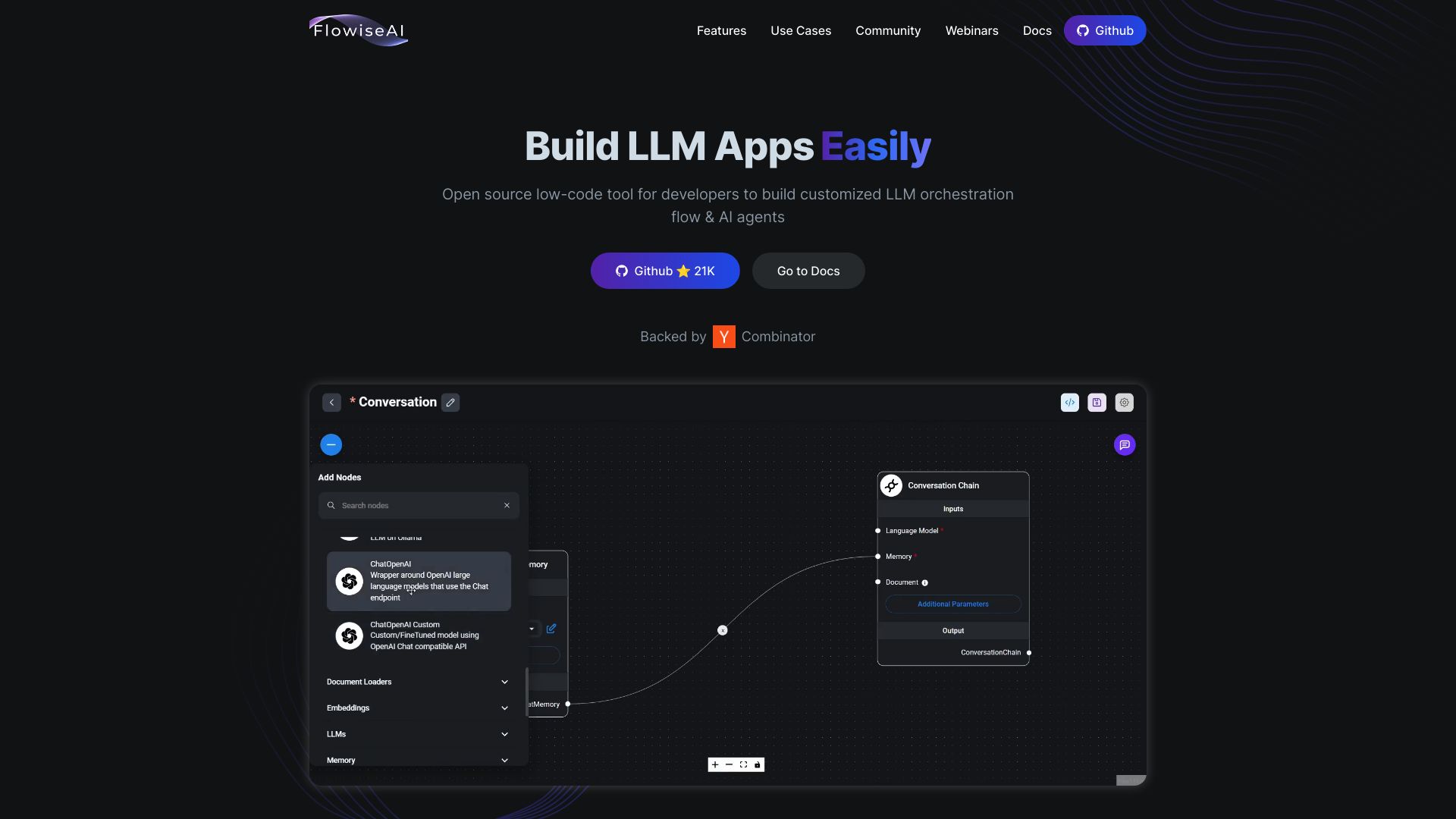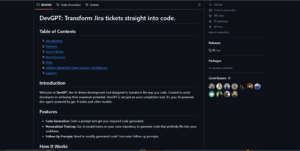FlowiseAI vs. DevGPT: AI-Powered Development Tools Compared
AI tools for software development have transformed how we create, manage, and optimize code. FlowiseAI vs. DevGPT offer unique approaches to streamline development processes, each with distinct strengths. FlowiseAI empowers users to build complex AI workflows visually, while DevGPT excels at generating code from natural language prompts. This comparison explores their key features, capabilities, and limitations to help developers, business leaders, and AI enthusiasts choose the right tool for their needs. We’ll also introduce SmythOS, a comprehensive platform that combines the best of both worlds and offers advanced features for enterprise-level AI development.
FlowiseAI Overview
FlowiseAI empowers developers to create customized AI workflows and agents using an intuitive, low-code platform. This open-source tool simplifies the process of building applications that leverage large language models (LLMs), making advanced AI capabilities accessible to a broader audience.
FlowiseAI’s visual interface allows users to design complex AI workflows through drag-and-drop functionality. Developers can rapidly prototype and deploy sophisticated LLM-based applications without deep technical expertise in AI. The platform supports integration with various document loaders, vector databases like Pinecone, and different data types including PDFs, web pages, and CSV files.
FlowiseAI empowers developers to create customized AI workflows and agents using an intuitive, low-code platform… making advanced AI capabilities accessible to a broader audience.


The platform’s modular approach employs an agent and chain system. Users link various nodes such as document loaders, text splitters, and LLMs to create tailored AI processes. This flexibility allows for the development of applications ranging from document analysis to customer support chatbots.
FlowiseAI offers pre-built templates and tools to accelerate development. These include document loaders for various file types, text splitters for chunking documents, vector database connectors for managing embeddings, and conversational retriever QA chains for question-answering tasks.
While FlowiseAI excels in many areas, it may have limitations in multimodal capabilities and direct integration with certain third-party services like Zapier. However, its open-source nature and focus on customization make it a valuable tool for developers and organizations looking to implement AI solutions efficiently and cost-effectively.
DevGPT Overview
DevGPT transforms natural language prompts into executable code, streamlining software development workflows. This open-source AI assistant focuses on automating coding tasks, saving developers significant time and effort.


DevGPT’s key features include personalized training on a developer’s codebase, editable AI-generated outputs, and integration with popular development tools like GitHub and Jira. The platform leverages advanced models such as GPT-4 and Codex to power its code generation capabilities, enabling developers to describe coding needs in plain English and receive context-relevant code snippets.
Users report significant productivity gains, with initial feedback suggesting over 10 hours saved per week on repetitive coding tasks.
Users report significant productivity gains, with initial feedback suggesting over 10 hours saved per week on repetitive coding tasks. DevGPT’s ability to understand project context and generate code tailored to a team’s specific style sets it apart from generic code generation tools.
While DevGPT offers powerful features for individual developers and small teams, it may face challenges in scaling to meet enterprise-level demands. The platform’s current focus on serving smaller development groups could limit its appeal to larger organizations requiring more robust security features, extensive API integrations, or advanced collaboration tools.
DevGPT aims to become an indispensable AI-powered coding companion for developers across various industries. Its vision includes expanding accessibility to companies of all sizes and building an engaged community of users and contributors to drive future product development. As the platform evolves, it will likely need to address scalability concerns and enhance its feature set to compete with more comprehensive AI development platforms in the market.
Feature Comparison
FlowiseAI and DevGPT both offer AI-powered development tools, but with distinct approaches and capabilities. FlowiseAI provides a visual, low-code platform for building AI workflows, while DevGPT focuses on generating code from natural language prompts.
FlowiseAI excels in its visual builder and no-code options, allowing users to create complex AI workflows without extensive coding. It supports various AI models, document types, and integrations with external services. However, FlowiseAI lacks some advanced features like multimodal capabilities and direct Zapier integration.
DevGPT, on the other hand, specializes in code generation from natural language inputs. It offers personalized training on a developer’s codebase and integrates with popular development tools like GitHub and Jira. DevGPT’s strength lies in its ability to understand project context and generate tailored code snippets. However, it may have limitations in scalability and enterprise-level features compared to more comprehensive platforms.
In terms of security, both platforms offer data encryption and OAuth support. FlowiseAI provides more robust security features, including constrained alignment to ensure AI behavior aligns with organizational goals. DevGPT’s security features are less explicitly detailed, which could be a concern for enterprise users with strict security requirements.
Feature Comparison Table
| FlowiseAI | DevGPT | SmythOS | |
|---|---|---|---|
| CORE FEATURES | |||
| Hosted Agents (Dev, Production) | ❌ | ❌ | ✅ |
| Environments (Dev, Production) | ❌ | ❌ | ✅ |
| Visual Builder | ✅ | ❌ | ✅ |
| No-Code Options | ✅ | ❌ | ✅ |
| Autonomous Agents | ✅ | ❌ | ✅ |
| Explainability & Transparency | ✅ | ❌ | ✅ |
| Debug Tools | ❌ | ✅ | ✅ |
| Multimodal | ✅ | ❌ | ✅ |
| Multi-Agent Collaboration | ❌ | ❌ | ✅ |
| Audit Logs for Analytics | ❌ | ❌ | ✅ |
| Work as Team | ❌ | ✅ | ✅ |
| Bulk Work | ✅ | ❌ | ✅ |
| Agent Work Scheduler | ✅ | ❌ | ✅ |
| Logs & Monitoring | ✅ | ❌ | ✅ |
| SECURITY | |||
| Constrained Alignment | ❌ | ❌ | ✅ |
| Data Encryption | ✅ | ❌ | ✅ |
| OAuth | ❌ | ❌ | ✅ |
| IP Control | ❌ | ❌ | ✅ |
| COMPONENTS | |||
| Foundation AIs | ✅ | ❌ | ✅ |
| Huggingface AIs | ✅ | ❌ | ✅ |
| Zapier APIs | ❌ | ❌ | ✅ |
| All other APIs, RPA | ✅ | ❌ | ✅ |
| Classifiers | ❌ | ❌ | ✅ |
| Logic | ✅ | ❌ | ✅ |
| Data Lakes | ❌ | ❌ | ✅ |
| DEPLOYMENT OPTIONS (EMBODIMENTS) | |||
| Deploy as API | ✅ | ❌ | ✅ |
| Deploy as Webhook | ✅ | ❌ | ✅ |
| Staging Domains | ❌ | ❌ | ✅ |
| Production Domains | ❌ | ❌ | ✅ |
| API Authentication (OAuth + Key) | ✅ | ❌ | ✅ |
| Deploy as Site Chat | ✅ | ❌ | ✅ |
| Deploy as Scheduled Agent | ❌ | ❌ | ✅ |
| Deploy as GPT | ✅ | ❌ | ✅ |
| Scalability | ✅ | ❌ | ✅ |
| DATA LAKE SUPPORT | |||
| Hosted Vector Database | ❌ | ❌ | ✅ |
| Sitemap Crawler | ❌ | ❌ | ✅ |
| YouTube Transcript Crawler | ❌ | ❌ | ✅ |
| URL Crawler | ✅ | ❌ | ✅ |
| PDF Support | ✅ | ❌ | ✅ |
| Word File Support | ❌ | ❌ | ✅ |
Best Alternative to FlowiseAI and DevGPT
SmythOS stands out as the superior alternative to FlowiseAI and DevGPT, offering a comprehensive platform for AI agent creation and deployment. We’ve designed SmythOS to address the limitations of other platforms while providing unparalleled flexibility and power.
Our visual builder simplifies the process of creating complex AI workflows, making it accessible to both technical and non-technical users. Unlike FlowiseAI’s limited integration options and DevGPT’s focus on code generation, SmythOS supports a wide range of AI models, APIs, and data sources. This versatility allows users to build sophisticated AI agents for virtually any use case.
SmythOS supports a wide range of AI models, APIs, and data sources. This versatility allows users to build sophisticated AI agents for virtually any use case.
SmythOS excels in scalability and deployment options, features lacking in both FlowiseAI and DevGPT. We offer hosted agents for development and production environments, seamless API integration, and the ability to deploy as chatbots or scheduled tasks. This flexibility ensures that AI solutions can grow with your business needs.
Security is a top priority for SmythOS. We provide robust features like data encryption, OAuth support, and IP control, addressing enterprise-level concerns that FlowiseAI and DevGPT may overlook. Our platform also emphasizes explainability and transparency, crucial for maintaining trust in AI systems.
With SmythOS, we’ve created a platform that combines ease of use with powerful capabilities, making it the ideal choice for businesses and developers looking to harness the full potential of AI technology. Whether you’re building a simple chatbot or a complex multi-agent system, SmythOS provides the tools and flexibility to bring your vision to life efficiently and effectively.
Conclusion
FlowiseAI and DevGPT offer unique approaches to AI-powered development, each with its own strengths. FlowiseAI’s visual builder empowers users to create complex AI workflows without extensive coding, while DevGPT excels in generating code from natural language prompts. Both platforms have carved out niches in the AI development landscape, but neither matches the comprehensive capabilities of SmythOS.
SmythOS stands out with its unparalleled versatility and ease of use. Our platform combines the visual building prowess of FlowiseAI with the code generation capabilities similar to DevGPT, while offering a host of additional features. SmythOS supports multimodal interactions, enables problem-solving across various domains, and provides robust tools for multi-agent collaboration. The platform’s extensive integration ecosystem, with over 300,000 pre-built connections, far surpasses the offerings of both FlowiseAI and DevGPT.
Where FlowiseAI and DevGPT may struggle with enterprise-level demands, SmythOS shines. We offer advanced security features, including constrained alignment and data encryption, making our platform suitable for businesses of all sizes. Our “Create Once, Deploy Anywhere” approach allows for seamless integration across multiple environments, from chatbots to APIs, addressing scalability concerns that DevGPT may face.
For those looking to harness the full potential of AI in their workflows, SmythOS offers a compelling solution. We invite you to explore our platform and experience the future of AI development. Create a free account today and discover how SmythOS can revolutionize your approach to AI integration and automation.
Last updated:
Disclaimer: The information presented in this article is for general informational purposes only and is provided as is. While we strive to keep the content up-to-date and accurate, we make no representations or warranties of any kind, express or implied, about the completeness, accuracy, reliability, suitability, or availability of the information contained in this article.
Any reliance you place on such information is strictly at your own risk. We reserve the right to make additions, deletions, or modifications to the contents of this article at any time without prior notice.
In no event will we be liable for any loss or damage including without limitation, indirect or consequential loss or damage, or any loss or damage whatsoever arising from loss of data, profits, or any other loss not specified herein arising out of, or in connection with, the use of this article.
Despite our best efforts, this article may contain oversights, errors, or omissions. If you notice any inaccuracies or have concerns about the content, please report them through our content feedback form. Your input helps us maintain the quality and reliability of our information.
